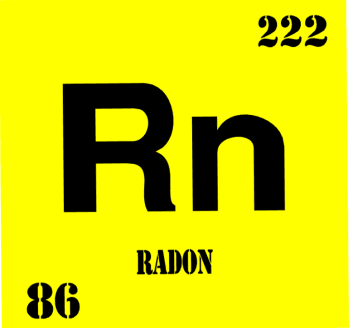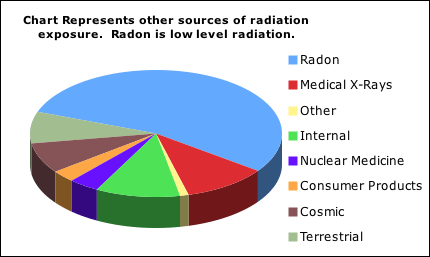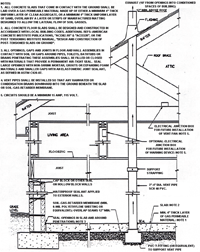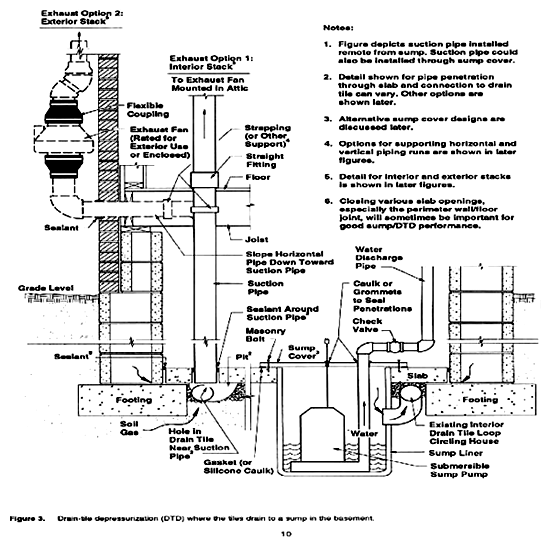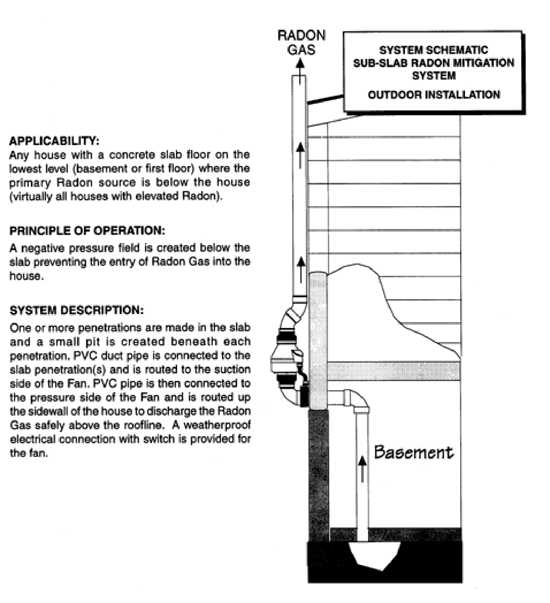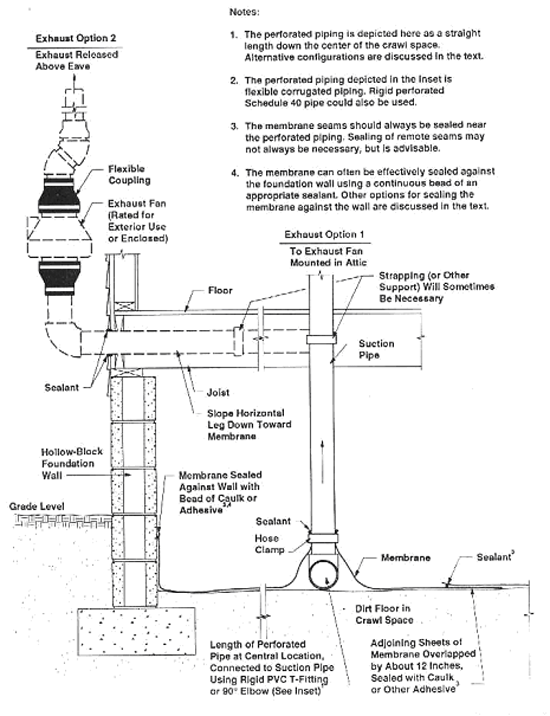About Radon
What is Radon?
Radon is estimated to cause 14,000 – 30,000 deaths each year. In fact, the Surgeon General has warned that radon is the second leading cause of lung cancer in the United States today. Only smoking causes more lung cancer deaths. If you smoke and your home has high radon levels, your risk of lung cancer is even greater.
Radon comes from the natural (radioactive) breakdown of uranium in soil, rock and water and gets into the air you breathe.
Radon can be found all over the U.S. It can get into any type of building - homes, offices, and schools - and build up to high levels. But you and your family are most likely to get your greatest exposure at home. That's where you spend most of your time.
You should test for radon
Testing is the only way to know if you and your family are at risk from radon. The EPA and the Surgeon General recommend testing all homes at the lowest occupied space. Real estate transactions require testing in the lowest livable space. The EPA also recommends testing in schools. Millions of Americans have already tested their homes for radon.
High radon levels can be reduced
The EPA recommends that you take action to reduce your home's indoor radon levels if your radon test result is 4 pCi/L or higher. If you are selling your home it would be more advantageous to correct a radon problem prior to placing your home on the market as you will have more time to address the radon problem and there won't be cause for any re-negotiations during the actual transaction.
The Health Risk of Radon Gas
How Does Radon Induce Cancer?
Radon is a Class A known human carcinogen. If inhaled, radon decay products (polonium-218 and polonium-214, solid form), unattached or attached to the surface of aerosols, dusts, and smoke particles, become deeply lodged or trapped in the lungs, where they can radiate and penetrate the cells of mucous membranes, bronchi, and other pulmonary tissues. The ionizing radiation energy affecting the bronchial epithelial cells is believed to initiate the process of carcinogenesis. Although radon-related lung cancers are mainly seen in the upper airways, radon increases the incidence of all histological types of lung cancer, including small cell carcinoma, adenocarcinoma, and squamous cell carcinoma. Lung cancer due to inhalation of radon decay products constitutes the only known risk associated with radon. The use of tobacco multiplies the risk of radon-induced lung cancer.
What About Smoking and Radon Exposure?
Some people ask whether the lung cancer deaths attributed to radon exposure actually may be the result of smoking. A 1989 study by researchers from the National Institute for Occupational Safety and Health, the Centers for Disease Control, the Harvard School of Public Health, and the University of California at Davis demonstrated a greatly increased lung cancer risk in nonsmoking uranium miners exposed to high radon concentrations: compared to typical non-smoking populations, these miners had nine (9) to twelve (12) times the risk of developing lung cancer (Roscoe et al, JAMA 262(5): 629-633, 1989).
Evidence from some of the epidemiological studies of underground miners, primarily U. S. uranium miners, indicates that radon exposure and smoking may have a synergistic relationship. Either smoking or radon exposure can independently increase the risk of lung cancer; however, exposure to both greatly enhances that risk.
As you can see radon is by far the greatest single source of radiation exposure to the public.
Radon Reduction Techniques
We at Radon Rescue, as well as the EPA typically recommend the installation of a system that prevents the entry of radon into your home. Soil suction, also known as Active Reduction prevents radon from entering your home by creating a larger negative pressure under the home. Which circumvents the mechanics that brings radon in. The systems termination point is above the house where it is quickly diluted. Any information that you may have about the construction of your house could help us choose the best system for your home. The EPA does not recommend performing passive reduction by itself, as it has not been shown to lower radon levels significantly or consistently. The Illinois Department of Nuclear Safety/IEMA does not recognize passive reduction as a form of mitigation.
The Disclosure Act...
The Illinois Real Property Disclosure Act, effective October 1994, requires that a home seller disclose any knowledge about radon levels in the home. The act does not require that testing or remediation work be conducted. However, many relocation companies and lending institutions, as well as home buyers, request a radon test when purchasing a house. Sellers and brokers are cautioned to err on the side of full disclosure of material facts prior to entering into a purchase agreement.
If the test results show radon levels above 4 pCi/L...
You should take steps to have your home professionally mitigated to reduce the radon levels.
After a radon reduction system is installed...
A short-term test should be conducted to ensure that the reduction system is effective. Make sure the system is operating during the entire test.
Building a new home?
Should you take preventive measures during construction?
If you are building a new home there is no reliable way to test the soil before construction. Soil testing has been tried and shown and proven to be unreliable, the end result will always be the same, pre-running pipe will be recommended. If you can even find someone to do the test the cost can exceed the price of taking radon reducing measures. Testing the top soil won't tell you if you will have a problem down below your foundation and there are other factors that will influence the radon level once the home is built.
PASSIVE SUB-SLAB DEPRESSURIZATION RADON
CONTROL SYSTEM FOR NEW CONSTRUCTION
Benefits of installing a radon vent pipe:
Can reduce humidity in the basement.
Can decrease odors.
May reduce mold.
Radon is not the only gas below your home, natural decomposition of organic matter creates ammonia, methane and carbon dioxide that can also enter your home.
EPA INFORMATION
Radon causes an estimated 14,000 - 30,000 lung cancer deaths each year. It is the Earth's only naturally produced radioactive gas and comes from the breakdown of uranium in soil, rock, and water. You cannot see or smell radon, but it can become a health hazard when it accumulates indoors. It can enter your home through cracks and openings in the foundation floor and walls. When radon decays and is inhaled into the lungs, it releases energy that can damage the DNA in sensitive lung tissue and cause cancer.
Simple and inexpensive techniques reduce radon levels on average by 50%. The techniques may also lower levels of other soil gases and decrease moisture problems.
Building in the features is much cheaper than fixing a radon problem later.
The techniques described here also make your home more energy efficient and could provide you an average of $65 savings per year in your energy costs.
If high levels of radon are found, a fan can easily be installed as part of the system for further radon reduction.
Average cost to install radon-resistant features in an existing home: $800 - $2,500
Average cost to install radon-resistant features during new home construction: $350 - $500
The techniques may vary for different foundations and site requirements, but the basic elements are:
A. Gas Permeable Layer
This layer is placed beneath the slab or flooring system to allow the soil gas to move freely underneath the house. In many cases, the material used is a 4-inch layer of clean gravel.
B. Plastic Sheeting
Plastic sheeting is placed on top of the gas permeable layer and under the slab to help prevent the soil gas from entering the home. In crawl-spaces, the sheeting is placed over the crawlspace floor.
C. Sealing and Caulking
Openings in the concrete foundation floor are sealed to reduce soil gas entry into the home. EPA does not recommend the use of sealing alone to reduce radon levels.
D. Vent Pipe
A 3- or 4-inch gas-tight or PVC pipe (commonly used for plumbing) runs from the gas permeable layer through the house to the roof to safely vent radon and other soil gases above the house.
E. Junction Box
An electrical junction box is installed in case an electric venting fan is needed later.
Radon is the second leading cause of lung cancer after smoking.
High radon levels have been found in every state.
Levels can vary widely, even from home to home in the same neighborhood.
Radon levels can be lowered, and homes can be built radon-resistant.
Simple, inexpensive techniques can be used to lower radon levels and increase energy efficiency in your new home. Here are basic steps to follow when buying a new home.
1. Check Your Area's Radon Potential
Find out if you are buying a home in a high radon area. The Environmental Protection Agency's map of radon zones shows which areas have the greatest potential for elevated indoor radon readings. Homes in places with high radon potential, called Zone 1 areas (most of Illinois is in Zone 1), should be built with radon-resistant features.
2. Install a Radon Reduction System
Talk to your builder about the installation of radon resistant features in your new home. Radon Rescue can easily install these features at a very reasonable cost.
3. Remember: Test Your Home
Every new home should be tested for radon after occupancy. Have your home tested by a licensed professional even if it has the radon resistant features. The EPA recommends retesting your home every 2 years.
4. If Radon Levels Are Still High, Activate
If your home tests at 4.0 picocuries per liter (pCi/L) or above, activate the system. Call us at Radon Resuce to activate your system.
House/System Diagram
Our house is a cutaway drawing of radon reductions systems installed.
Descriptions
Cold Joint:
The point where the foundation wall and floor meet is one of the primary sources of radon entry on poured concrete foundations. Accessible cold joints are cleaned and caulked.
Exhaust:
A few of the exhaust requirements are: termination point above the eave, minimum of 10 feet off the ground, 10 feet horizontally from windows or doors or a minimum of 2 feet above a window or door if above the edge of the roof and within 10 feet from doors or windows.
All our exhaust openings are protected with a stainless steel screen to prevent debris from falling into the fan. CAPS OR COVERS ARE NOT ALLOWED ON EXHAUSTS. Rain will not hurt the fan. The use of caps or covers will increase the amount of moisture inside the radon piping, and will hamper the system’s performance and void our warranty. All exhausts should point upwards.
Fan:
Our fans are specifically designed for radon reduction systems. The fans have a 3 -year warranty and a life expectancy of over 10 years. Fan sizes and performance can vary. Over the years we have found eight various models that have different performance characteristics and exceed our expectations every time.
Floor Drains:
Although most floor drains are trapped just like your sink drains, not all are. If your floor-drain holds water it is probably not a source of radon. Check your drain with a flashlight, you may need to pour water into the drain and wait 5 minutes, if no water is present your drain will need to be sealed.
Trench Drains:
Trench drains have direct contact with soil and also circumvent our negative pressure field. To adequately install a mitigation system we need to negate the effectiveness of the drain.
Piping:
The main run of radon pipe, from floor to exhaust is always a minimum of 3" schedule 40 PVC pipe as required by Illinois law. A minimum of 3" pipe is used to reduce air- flow restrictions caused by smaller pipes and allows for proper drainage. Secondary pipe runs can be a smaller pipe size. Larger size pipe may be needed although this is rare.
Sumps:
Sump pits are designed to collect ground (rain) water from under and around the foundation through a network of drain tiles. The system is in direct contact with the soil and is sealed by us. Because of this it is important for us to know what kind of sump pump and back-up system you have.
Block wall foundations:
Can be a major source of radon entry, tops of block walls should be capped or sealed when possible. Block walls usually require multiple suction points
U-Tube/Man-O-Meter:
Indicates that your radon fan is operating by measuring the amount of suction created by the fan. The u-tube DOES NOT measure radon levels
Slab Homes
At least one 4- inch hole is cored (drilled) through the slab. A small pit is hollowed out beneath the hole, and a PVC pipe is inserted. This pipe is routed to a fan that creates a vacuum beneath the slab. The number of suction points depends on the permeability of the soil beneath the slab and the number of footings within the building.
A single radon vent pipe is often all that is required in a residence. A general "rule of thumb" suggests the use of one vent pipe for roughly each 2,000 square feet of floor space at ground level.
Under Slab Ductwork
In some homes, return-air ductwork for the forced-air conditioning system is located beneath a slab floor. Although this can increase usable interior space and reduce the noise of re-circulating air inside the home, the sub-floor ductwork, if unsealed, can add to radon problems. When the air conditioner fan is on, a fairly large vacuum effect created in the buried ductwork can draw radon-laden soil gas through the ducts and into the living space. Not all homes that have under-slab return ducts will have radon concerns. The only way to know is to test.
Sketch of an outdoor system
Crawl Space:
Dirt and gravel crawl spaces are covered and sealed to prevent radon entry. Sealing crawls can actually help reduce dust, molds and humidity in the home. A high- density polyethylene sheet is laid on the soil. The seams are sealed, and the edges are sealed to the foundation walls. A perforated pipe or drain mat is placed beneath the plastic. This pipe is typically connected to solid PVC piping and fan, which creates a vacuum beneath the plastic. This effectively collects the radon and exhausts it to a safe location outside.
